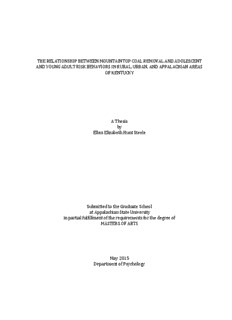Table Of ContentTHE RELATIONSHIP BETWEEN MOUNTAINTOP COAL REMOVAL AND ADOLESCENT
AND YOUNG ADULT RISK BEHAVIORS IN RURAL, URBAN, AND APPALACHIAN AREAS
OF KENTUCKY
A Thesis
by
Ellen Elizabeth Hunt Steele
Submitted to the Graduate School
at Appalachian State University
in partial fulfillment of the requirements for the degree of
MASTERS OF ARTS
May 2015
Department of Psychology
THE IMPACT OF MOUNTAINTOP COAL REMOVAL ON ADOLESCENT AND
YOUNG ADULT RISK BEHAVIORS IN RURAL, URBAN, AND APPALACHIAN AREAS OF
KENTUCKY
A Thesis
by
ELLEN ELIZABETH HUNT STEELE
May 2015
APPROVED BY:
__________________________________________
John Paul Jameson, Ph.D.
Chairperson, Thesis Committee
__________________________________________
Will Canu, Ph.D.
Member, Thesis Committee
__________________________________________
Kurt Michael, Ph.D.
Member, Thesis Committee
__________________________________________
James Denniston, Ph.D.
Chairperson, Department of Psychology
__________________________________________
Max C. Poole, Ph.D.
Dean, Cratis D. Williams School of Graduate Studies
Copyright by Ellen Elizabeth Hunt Steele 2015
All Rights Reserved
Abstract
THE IMPACT OF MOUNTAINTOP COAL REMOVAL ON ADOLESCENT AND YOUNG
ADULT RISK BEHAVIORS IN RURAL, URBAN, AND APPALACHIAN AREAS OF
KENTUCKY
Ellen Elizabeth Hunt Steele
B.A., University of North Carolina at Chapel Hill
M.A., Appalachian State University
Chairperson: John Paul Jameson
In Appalachia, coal mining has historically been a major source of industry, yet it
is associated with significant environmental and health consequences, including
increases in rates of depression, cancer, cardiac and respiratory diseases, birth defects,
low birth weight, and overall poor physical health and stress. However, there is a dearth
of research on the effect of mountaintop coal removal (MTR) mining on mental health in
Appalachia, particularly on adolescents and emerging adults. In the current study, using
a statewide emergency department dataset, groups of emerging adults from
Appalachian and non-Appalachian areas, both with and without MTR, were compared.
It was hypothesized that both location in Appalachia and the presence of MTR would be
positively associated with relatively higher odds of risky behaviors including self-harm,
substance use, and sexually transmitted infections. Cases from a statewide emergency
department database (n = 347,531) were separated into groups of adolescents and
emerging adults from rural and non-rural, Appalachian and non-Appalachian areas,
with and without MTR. These groups were compared through a series of binary logistic
iv
regressions. Adolescents and emerging adults in Appalachia, rural Appalachia, and rural
Appalachia with MTR had relatively higher odds of diagnosis of a polysubstance use
disorder. Additionally, adolescents and emerging adults experienced increased odds of
a diagnosis with of an alcohol use disorder in rural Appalachia and rural Appalachia
with MTR. Overall, this suggests that MTR may play a role in influencing substance use
in rural Appalachia, but more research is needed to explore the relationship.
Keywords: Appalachia, emerging adult, rural, risky behaviors, coal mining
v
Acknowledgments
I would like to thank my thesis chair, Dr. John Paul Jameson, for his patient
guidance and support throughout the development of this thesis project. Similarly I
would like to extend my gratitude to my thesis committee, Drs. Will Canu and Kurt
Michael, for their thoughts, feedback, and support in assisting me in completing this
thesis. Additionally, I would like to thank Michael Denslow at the National Ecological
Observatory Network for his assistance locating and categorizing coal mines in
Kentucky.
vi
Dedication
I would like to dedicate this manuscript to my parents and my fiancé for their ongoing
love and support through my master’s career and this project.
vii
Table of Contents
Abstract ...................................................................................................................................................... iv
Acknowledgments ................................................................................................................................. vi
Dedication ................................................................................................................................................ vii
List of Tables ............................................................................................................................................ ix
List of Figures ........................................................................................................................................... x
References .............................................................................................................................................. 30
Vita ............................................................................................................................................................. 56
viii
List of Tables
Table 1. Demographic differences between communities with and without
MTR.......................……………………………………………………………..…………………………...........44
Table 2. Comparison of Young Adult Risk Behaviors in ED cases from MTR and
non-MTR counties……….………………………………………………..………………………………….45
Table 3. Binary logistic regression results for Polysubstance use cases with
Interaction…………………………………………………………………..……………………………….…..46
Table 4. Binary logistic regression results for Alcohol use diagnoses cases with
5Interaction……………………………...………………………………………………………………….…..47
Table 5. Demographics for Rural Appalachia………………………………………………...……48
Table 6. Risky Behaviors in Rural Appalachia..........................................................................49
Table 7. Alcohol use in Rural Appalachia…………………………………………………………....50
Table 8. Polysubstance use in Rural Appalachia………………………………………………….51
ix
List of Figures
Figure 1. Proportion of cases with Alcohol use diagnosis.……………………………………52
Figure 2. Proportion of cases with Polysubstance use diagnosis………………………….53
Figure 3. Three-way Interaction of Alcohol use diagnosis…….……………………………..54
Figure 4. Three-way Interaction of Polysubstance use diagnosis..………………………..55
x
Description:of research on the effect of mountaintop coal removal (MTR) mining on Keywords: Appalachia, emerging adult, rural, risky behaviors, coal mining .. associated with unsafe sexual practices, particularly having multiple sexual partners . Cordial, Riding-Malon, and Lips (2012) focus on solastalgia, or

